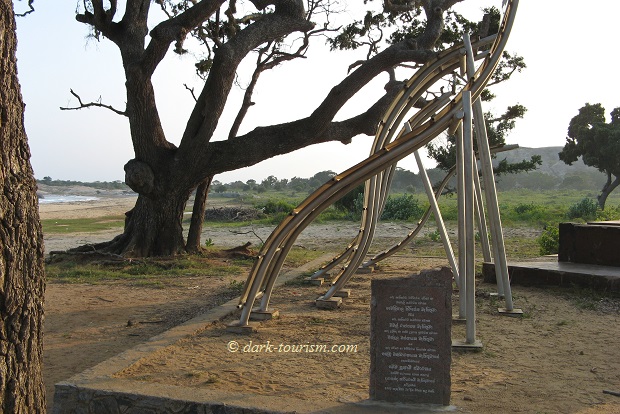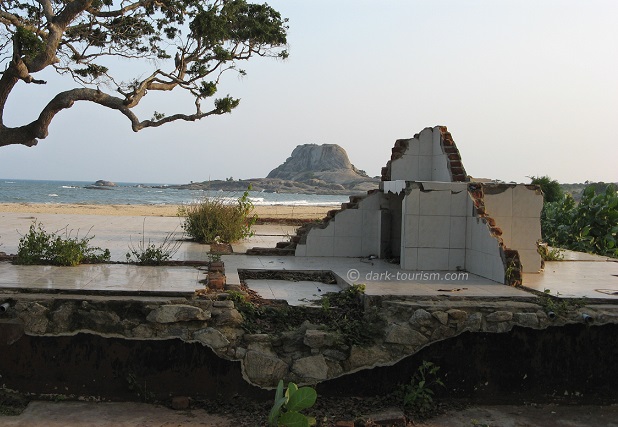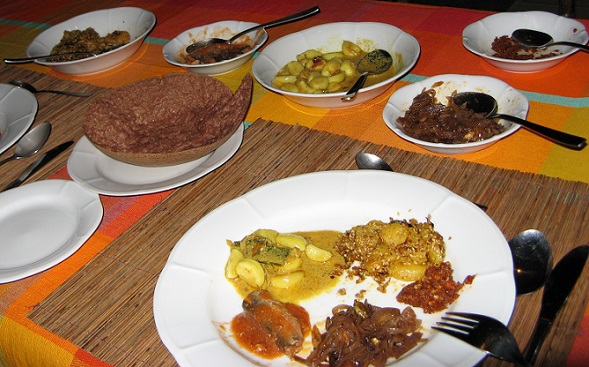This was the last photo I was still able to put on DT’s Facebook page before it/I was purged. I’m reusing it here (see original post text below), however, for a different reason, namely because I’ve been thinking about Sri Lanka a lot more recently. And the reason for that is this: last week I “attended” (at home) an online ‘Zoom’ meeting that was organized by the travel company ETG (whom I’ve used several times for my travels in Asia, including Sri Lanka). This featured a presentation by travel author John Gimlette, who wrote a seminal book (called “Elephant Complex”) about Sri Lanka, its long and complex history, its many contradictions, the decades-long civil war that only recently came to an end (and that still warrants some deeper investigation), but also about lighter aspects, such as the stunning scenery and the wonderful cuisine.
The presentation was very illuminating and engrossing. Unfortunately, I hadn’t managed to finish reading the book before the presentation and had only got halfway through, but I’m now continuing. It also made me reminisce about my own trip to Sri Lanka many years ago, in 2006/7. That was before I had even heard of dark tourism (that came later in 2007), and the Sri Lanka itinerary wasn’t yet as tailored towards the dark sides as all my trips are these days. But it wasn’t totally lacking the darker side of travel. In Yala National Park we visited a monument to the victims of the 2004 Boxing Day tsunami next to the ruins of a house that had been destroyed in the wave and its occupants (including Japanese and German tourists) were killed and washed away, two were never found. Here’s a couple of photos, one of the monument and the other of the ruins, as they were when I was there (I’ve meanwhile been informed by someone who visited the place last year that little of the ruins are left and that the monument is in a bad state).


At that time, the civil war was still ongoing, as was the associated terrorism – which is why we didn’t stay in the capital Colombo (as that was frequently hit by bombs) or venture to the north or east of the country, then considered too dangerous. However, on our last drive, from near Galle back to Colombo airport, we passed the scorched wreck of a bus that had been the target of another terrorist attack a couple of days earlier. That brought it home a bit more, in what state the country was.
Now the civil war is over, after the government forces brutally stamped out the last resistance by the Tamils in the north and more or less eradicated the “Tamil Tigers” rebel army/organization. You can now visit those parts of the country again, including a few sights/sites associated with the civil war, though a couple have since disappeared. I had been toying with the idea of a return trip to Sri Lanka, this time focusing on the north, potentially even this coming winter. But that’s now off the table due to the coronavirus pandemic. But who knows, maybe we will at some point be able to travel freely again, and then I’ll get back to that idea.
The photo at the top of this post was taken at the second place where we stayed in Sri Lanka, called Illuks, which was a very interesting place: we were the first paying guests, guinea pigs, as it were, at a private mountain retreat owned by member of the Sri Lankan elite and retired airline pilot who’d had enough of “air-conditioned life”, as he put it, and wanted to get “back to nature”. Yet he was heading back to Colombo to take his two sons back to school – as good-quality schooling was still only to be found in the capital, he said. So they were leading a compromise life – part big city, part back in the remote countryside.
And the countryside surrounding this retreat, in a part of the highlands called the “Knuckles Range”, is indeed very scenic, but rarely visited by regular tourists. But the views we had from near the house were very fine indeed. Here’s an example:

The house had no electricity, except for a solar panel providing just enough power for a few lights and a small stereo; but there was no TV, and only “bucket showers”. But despite all the understatedness and rustic basicness, it was a great stay, wonderfully remote and atmospheric. Food-wise it was sublime. The staff consisted of two Tamils (who were basically “owned” by the owner of the house), a male servant, and a woman who was both gardener/farmer and cook. All day she would toil away, harvesting ingredients from the estate’s own organic garden and then spend hours preparing outstanding meals for us, authentically spiced (i.e. very hot!), as our driver-guide had explained to her that we do mean it when we say we like it spicy. So he told her “they eat like us” and asked her to make us this and that, including various dishes that normally wouldn’t feature much, if at all, on regular tourists’ tables (e.g. cashew curry, milk curry, garlic curry, fruit seeds, curry leaf congee, and what not). It was fire-eaters’ foodie heaven. Here’s a photo of one of our dinners (and don’t let the portion size mislead you – whenever a bowl was emptied, a second one would come our way within a minute; we quickly learned that the only way to stop the endless supply was to leave something in the bowl):

The estate was a former tea plantation, and the ruins of some of the tea processing buildings were just a short walk from the house we stayed in. One of those ruins is seen in the photo above. The ground all around this ruin, and indeed everywhere in the land where there was vegetation, was infested with leeches, so we wore proper hiking boots and made sure to get rid of any leeches trying to climb up. The owner and his sons had been walking around barefoot as they showed us around the first evening before they set off for Colombo. They were routinely removing leeches from their feet every few metres, and showed us the technique. But when we went exploring the next day we were not taking any chances. I found those leeches totally creepy, so we mostly stayed on dry land. But you couldn’t avoid them 100% when walking through the grounds of the estate. I was wondering how its ca. half a dozen cats coped with the leeches, as they were prowling through the grass freely, but never seemed to have any issues with them. Maybe having fur is the answer.
But back to the original Facebook post. I still owe you the (final) text that originally came with it. Here it is:
“On this Day, only a year ago, on 21 April 2019, Easter Sunday, six sites in Sri Lanka, three churches and three hotels in the capital Colombo, were targeted in a series of terrorist suicide bomb attacks, committed by a local Islamist militant group. Over 250 people were killed and more than twice that injured. It came only a month after the attacks on Muslims in Christchurch, New Zealand (though the alleged link, of the Sri Lankan Easter attacks having been in retaliation for the New Zealand attacks, was never confirmed).
The immediate aftermath saw curfews, a shutdown of social media, and the Sri Lankan authorities claimed they prevented further attacks planned by the same Islamist group.
Longer-term, the Easter attacks led to almost a collapse of the country’s tourism sector. The company that had organized my trip to Sri Lanka years earlier then sent a call to former clients for support, especially for the many driver-guides who were suddenly without an income. So we too donated to a charity scheme providing financial aid to help them tick over for the duration of the crisis. It worked and slowly but surely the tourism sector, and the driver-guides’ livelihoods, recovered.
And then, less than a year later, came the current corona virus pandemic bringing the entire tourism industry in Sri Lanka to a standstill, as elsewhere. How this second disastrous crisis could be overcome is beyond me … I fear the damage will be substantial and lasting …
I obviously have no photos of the 2019 Easter attacks, so I just trawled through my archive and picked a random picture taken on my 2006 Sri Lanka trip that at least vaguely fits into DT. This is the ruin of an abandoned tea factory in Illuks high in the central mountains (the ‘Knuckles Range’ to be precise).”





3 responses
Really glad you enjoyed the SL trip after our previous discussion on messenger. Your trip looks fantastic.
It was! But it was quite a long time ago. Now reading John Gimlette’s book I feel like I really should go on a longer return trip to the country and take in places in the east and north that were out of bounds for tourists back when I was first there. One day maybe …
…don’t keep it too long!